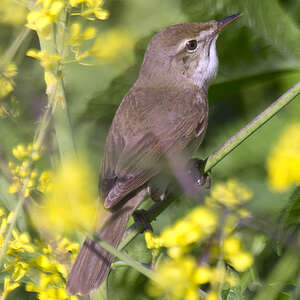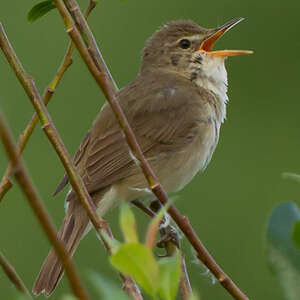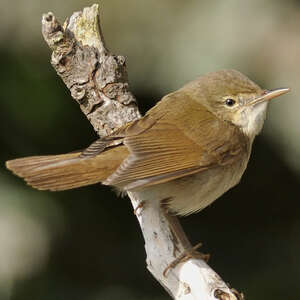Blyth's Reed Warbler
Acrocephalus dumetorum - Rousserolle des buissons
Identification
Blyth's Reed Warbler is very similar to the grasshopper warbler and should be compared to it. They both have the same size and shape, with a few minor differences. Blyth's Reed Warbler is more streamlined, with a stronger, slightly longer beak, a lower and longer forehead, and a less rounded crown. On the other hand, its tail is slightly longer, less rounded, and held straighter, even slightly raised at times. The male and female are identical. In fresh plumage, the upperparts of adults are very uniform, a cool brown or gray-brown, even in bright light. The front of the crown is a slightly warmer brown-brown. The nape and sides of the head and neck are shaded with gray. The rump and coverts are slightly lighter than the mantle. The flight feathers and rectrices are dark brown, bordered by medium brown, with no clear contrast. The white eyebrow, which is very clear in front of the eye, extends backward in a small white comma that quickly fades. The eyebrow is highlighted by the darkened edge of the crown and underlined by the dark, mottled loral streak. The eye is surrounded by a well-defined white ring, interrupted in front by the loral streak and in the back by a darker orbital streak that is more visible below the eye as it blends into the eyebrow above. The brown-gray ear coverts have whitish streaks that overflow onto the beige cheeks. The underparts are whitish but with a clear gray hue on the sides of the chest and flanks. The throat and under-tail coverts are white. The underside of the wings and axillaries are tinged with pale gray. The beak has a yellow lower jaw that darkens in the distal part. The legs are reddish or pinkish brown and appear dark from a distance.The fingers are more grey with dark nails. The iris is dark brown to light brown. In worn plumage, the color of the upper parts is even cooler. The eyebrow and eye ring are whiter. The undersides are whiter, with just a slight chamois-grey suffusion on the flanks. All the remiges and rectrices show obvious signs of wear.
Subspecific information monotypic species
Foreign names
- Rousserolle des buissons,
- Carricero de Blyth,
- felosa-das-moitas,
- Buschrohrsänger,
- berki nádiposzáta,
- Struikrietzanger,
- Cannaiola di Blyth,
- busksångare,
- Busksanger,
- trsteniarik krovinový,
- rákosník pokřovní,
- Buskrørsanger,
- viitakerttunen,
- boscarla dels matolls,
- Elrisöngvari,
- zaroślówka,
- krūmu ķauķis,
- robidna trstnica,
- Садовая камышевка,
- ヤブヨシキリ,
- 布氏苇莺,
- นกพงนาพันธุ์อินเดีย,
- 布萊氏葦鶯,
Voice song and call
The song is reminiscent of the Common Grasshopper Warbler's by the many imitations it comprises, but it is louder, less rapid, more repetitive, more measured and marked by more pauses. The verses are uttered with a slower rhythm. It includes typical ascending whistles of this species repeated such as a sii-ii-you and recurrent teck-teck as well as various elements characteristic of the Acrocephalus genus. From a distance, the repetition of syllables can resemble the Song Thrush. The imitations are perfect, like the Grasshopper Warbler's, mostly of passerines but also of non-passerines such as the European Wryneck, as was the case recently in Lorraine.
Habitat
Blyth's Reed Warbler frequents a wide variety of habitats, distinctly different from those of the Marsh Warbler, and to a lesser extent, those of the Eurasian Reed Warbler.
Behaviour character trait
Blyth's Reed Warbler is much more arboreal than the Great Reed Warbler and spends much of its time in deciduous thickets.
It hunts its prey in the vegetation moving actively in the foliage of trees and shrubs. It sometimes captures flying prey that it grabs with its beak or pursues over a short distance. It also sometimes hunts in herbaceous areas like its congener, or even descends to the ground to feed, recalling a small Turdidae in this. On average, it is less hidden than most other species of the genus Acrocephalus. The male does not try to hide when singing in a tussock of nettles or a clump of willows. This species has the habit of slightly raising its tail on occasion, which gives it a characteristic silhouette that the Anglophones call banana posture.Dietfeeding habits
Reproduction nesting
The first arrivals come to the southern parts of the breeding ground at the end of April or beginning of May.
At the northern parts or in higher altitudes, they don't arrive at the best until mid-May. The couples are territorial and nest separately; their nests are 25 to 100 meters apart from each other. They choose a bush (willow, gooseberry, raspberry, honeysuckle, etc.) or tall grass, especially nettles, to settle. The nest is built from dry grass linked with spider web and padded with animal or plant hair. The clutch consists of 3 to 5 pale green eggs, splotched with brown-red, that the female lays between the end of May and mid-July. The female alone incubates the eggs for 12 days. Both parents feed the young that take flight at the age of 12 to 14 days, so at the end of June or mid-August. Blyth's Reed Warbler only succeed in one brood and start to prepare for the migration in the mid-August.Geographic range
The range of Blyth's Reed Warbler stretches from southern Finland and Estonia to Central Siberia, includes Kazakhstan and extends to the mountainous areas of northern Iran and Afghanistan, and the western Himalayas. In Europe, it is limited to the south by the course of the Dniepr, in northern Ukraine. This bird spends the winter further south in the Indian subcontinent, as far down as Sri Lanka. Every year at the end of summer, a few Blyth's Reed Warbler, probably mostly young birds, wander as far as Britain, or along the coastlines of the North Sea and the Atlantic. One can wonder about their final destination.
Threats - protection
IUCN conservation status
concern
in the Wild
threatened
evaluated
Sources of information
- IOC World Bird List (v15.1), Gill, F and D Donsker (Eds). 2025-12-07.
Other sources of interest
 Specification sheet created on
27/07/2023 by Jean François
Specification sheet created on
27/07/2023 by Jean FrançoisTranslation by AI Oiseaux.net
© 1996-2025 Oiseaux.net
- Accipitriformes
- Aegotheliformes
- Anseriformes
- Apodiformes
- Apterygiformes
- Bucerotiformes
- Caprimulgiformes
- Cariamiformes
- Casuariiformes
- Charadriiformes
- Ciconiiformes
- Coliiformes
- Columbiformes
- Coraciiformes
- Cuculiformes
- Eurypygiformes
- Falconiformes
- Galliformes
- Gaviiformes
- Gruiformes
- Leptosomiformes
- Mesitornithiformes
- Musophagiformes
- Nyctibiiformes
- Opisthocomiformes
- Otidiformes
- Passeriformes
- Pelecaniformes
- Phaethontiformes
- Phoenicopteriformes
- Piciformes
- Podargiformes
- Podicipediformes
- Procellariiformes
- Psittaciformes
- Pterocliformes
- Rheiformes
- Sphenisciformes
- Steatornithiformes
- Strigiformes
- Struthioniformes
- Suliformes
- Tinamiformes
- Trogoniformes



























